Top 8 SaaS Trends for 2025 You Can’t Ignore
Summarize:
Key takeaways
- AI and machine learning are game-changers for SaaS. Users today expect apps to be smart and efficient. Without AI-powered features, apps can feel outdated fast. Adding AI keeps your product fresh and competitive.
- Offering flexible subscription plans and catering to niche markets is a smart move. These strategies help SaaS companies attract the right customers, keep them happy, and grow revenue at the same time.
- Prioritizing cybersecurity and sustainable practices builds trust and long-term success. Strong security keeps customers’ data safe, while sustainability boosts your brand’s reputation. It’s a win-win for both users and your business.
At Clockwise Software, we have developed for our clients more than 25 SaaS applications, with six more in different stages of development.
Despite different industries and requirements, our approach was common: we always build apps according to the latest trends. Why? That’s simple. Our clients want their apps to be:
- Competitive;
- Attractive;
- Future-proof.
Adopting innovative approaches can bring us there. So it’s our job as a SaaS development company to keep an eye on emerging industry tendencies.
In 2024 we worked with multiple emerging technologies and observed promising SaaS landscape shifts. One thing is clear: not all of them will last. Just a few will become the true SaaS trends for 2025-2026.
So what trends will have the biggest impact on the industry? Here are 8 trends that we will consider when building next-gen products for our clients in the next year:
- Artificial intelligence and machine learning
- Micro SaaS
- SaaS market consolidation
- Emphasis on security
- Changes in subscription models and pricing policies
- White-label SaaS
- Sustainability and energy efficiency
- Growing demand for collaboration software
Let’s talk about each SaaS trend in detail.
Artificial intelligence and machine learning
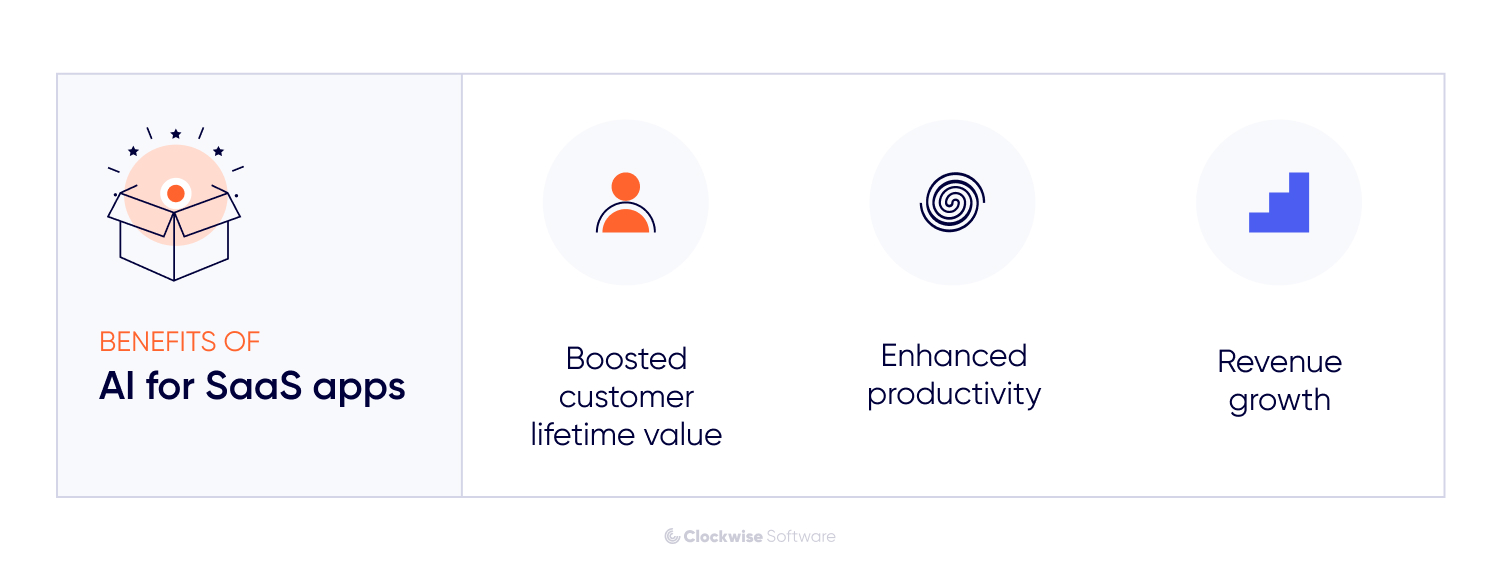
Today, the question isn't whether to adopt AI and ML in your SaaS application but how soon to adopt it.
Some of our clients fear that their app won’t reach success without AI functionality. And they are somehow right. Since large language models (LLMs) became mainstream, many users expect the SaaS apps to include generative AI integration. For many of them, this may become the crucial factor in choosing a software provider.
Understanding the fundamentals of AI application development is now a competitive advantage. It’s not just about adding an AI feature—it’s about building scalable, intelligent systems that learn from user behavior, automate complex processes, and continuously improve over time. By integrating AI thoughtfully, SaaS businesses can stand out in an increasingly saturated market.
Business value
So what do you get from implementing AI and ML functionality into your SaaS app?:
- Boosted customer lifetime value. A truly personalized experience keeps your users coming back. Companies leading in personalization are seeing revenue boosts between 10 and 15%. For some, a 25% increase is already a norm. AI helps you achieve this personalization. It’s not just a nice-to-have—it’s a revenue driver.
- Enhanced productivity. AI can give your team a productivity lift, too. Pros are predicting that AI could save up to 12 hours a week—adding up to about 6.5 working days per month. Tools like GitHub Copilot are already helping, with developers finishing tasks over 50% faster. Think about what your team could accomplish with that extra time!
- Revenue growth. AI adoption isn’t just a trend; it’s a proven business accelerator. Top AI startups reach $30 million in annual revenue in just 20 months — five times faster than traditional SaaS companies.
Impressive statistics, isn’t it? Let’s take a look at specific companies that benefit from AI implementation right now.
Real world examples
While choosing companies for our list of the most exciting SaaS startups in 2025, one thing stood out. Nearly every new application is AI-powered Here’s a sneak peek at a few standout examples:
- Univerbal is a language-learning buddy powered by AI. It uses LLMs to mimic fluid and dynamic conversations with native speakers. And clearly people love it. Univerbal attracted 50,000+ users in two days since launch. Now, the app has more than 100,000 downloads on Google Play Store alone.
- Vizcom is a game-changer for designers. This AI tool takes simple sketches and turns them into photorealistic renders almost instantlyInvestors are also impressed: the company attracted more than $25 million in less than two years.
- Vocode originally launched as a playful prank-call app. Vocode quickly pivoted when the founders saw a real demand for voice AI in customer support. Since 2023, they’ve raised more than $4 million and secured partnerships with some big names.
These startups are making smart moves by using AI to get an edge and compete with the big guys. With countless startups offering top-notch user experiences and advanced features, even the industry giants are having to step up their game.
Today, almost every major SaaS product has AI baked into its core. And what about the newbies? From our experience, most businesses start their SaaS app journey with AI app development in mind, building around AI strategies or planning for ML model integration in the near future.
You also don’t want to miss this trend, right? Then start with reading this article:
Read also:How to Create an AI SaaS Product
Micro SaaS
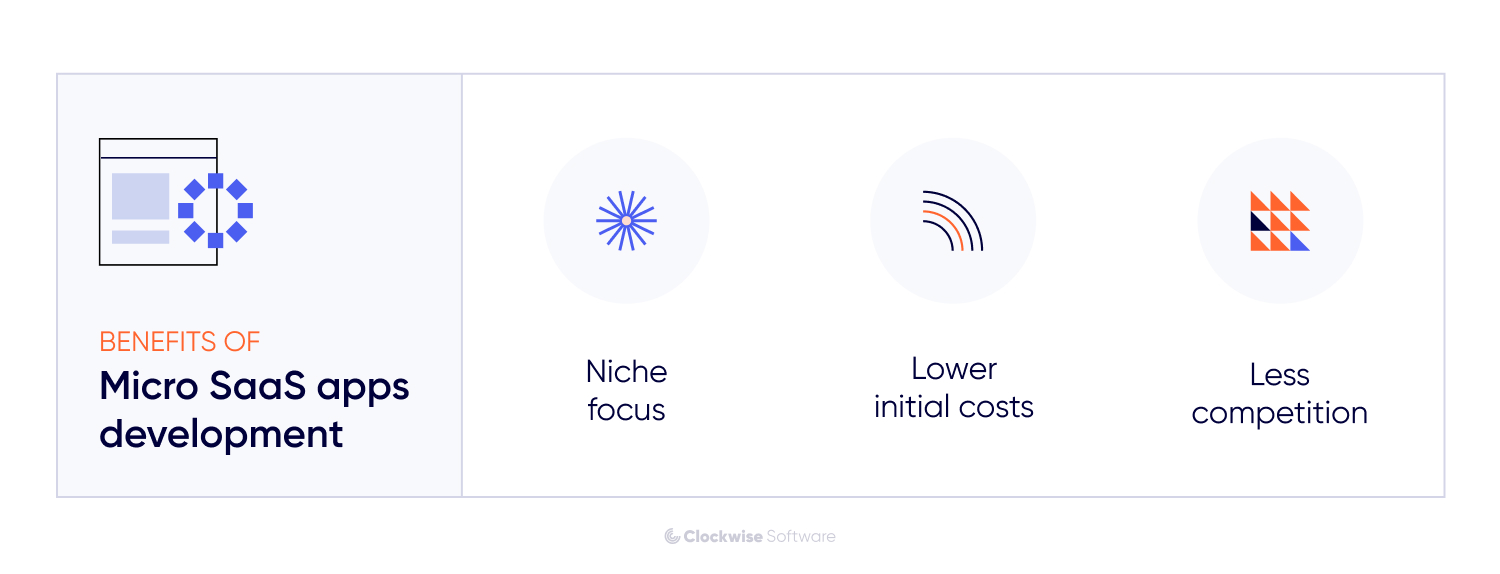
Big names like Salesforce, HubSpot, and Zendesk offer SaaS products that work across all kinds of industries. And let’s be real — competing with them head-on is tough. But here’s the thing: these big apps often don’t address the specific needs of smaller, niche audiences.
That’s where micro SaaS shines, offering focused solutions that really hit the mark for particular markets. Instead of trying to build the next universal ERP or CRM system, consider this — focusing on a niche might just be your ticket to success.
Business value
So, why does going niche work so well for SaaS startups? Let’s break it down:
- Niche focus. Micro SaaS apps solve specific problems that big platforms tend to overlook. For example, take regulatory compliance—large SaaS tools often struggle to stay up-to-date with all the rules changes in all industries. Niche apps can deliver compliance-ready features that meet exact needs. Salesforce claims that 76% of businesses prefer SaaS providers that know their needs and preferences.
- Lower initial costs. Launching a micro SaaS product doesn’t demand massive resources. You can roll out an MVP with a standout feature and start bringing in revenue within months. And here’s why timing is everything — a study by McKinsey & Company shows that a product released six months late can earn 33% less profit over the next five years compared to one launched on time. So, getting your MVP out there fast is a must.
- Less competition. When you focus on a specific audience and a clear problem, you can carve out a space that competitors haven’t flooded. This approach makes it easier to stand out and resonate with users who feel seen and understood.
Sounds promising, right? Now, let’s look at a few examples to see how micro SaaS has hit it big.
Real world examples
In recent years, we’ve rolled up our sleeves on several micro SaaS products and kept a close watch on even more during our startup market research. Here are a few standout products that show how niche focus leads to big results:
- BackupLABS came to us with a request: they needed a backup solution for specific services that big-name providers weren’t covering, but their clients needed. We helped them build a micro SaaS platform from scratch, starting with these key integrations and expanding as they grew. Today, it’s a hit — backing up over 4.5 million data units for its users.
- HR pros love HiPeople for making hiring smoother. With automated reference checks and AI-powered assessments, companies can close top talent faster. By precisely solving real hiring pain points, they’ve raised $6 million and grown fast.
- Senniors brings peace of mind to families by tracking seniors’ health through wearables. With over 40,000 families served in Spain, they’re now eyeing the U.S. market after raising $5 million in funding.
So, you’ve got an idea that’s itching to become a reality — but maybe you’re wondering, Is there already something like this out there? Is the market too crowded? That’s where we come in. At Clockwise Software, we’re here to help you find answers to these questions and turn good ideas into thriving products.
It all starts with discovery phase, where our team of technical experts, marketing professionals, and business analysts will do:
- Market analysis. We delve into your target market to understand trends and opportunities.
- Competitive assessment. We evaluate potential competitors to identify gaps your product can fill.
- Product development plan and estimates. We outline the implementation of a full-fledged micro SaaS app with scalable architecture and opportunities for growth. We make sure you receive not just a prototype but a product able to cover the target audience’s needs. And this all within your budget and timelines.
Micro SaaS offers amazing possibilities from the start. You can keep adding features and expand your app, stick to a specific niche, or even sell your product to a larger company.
We can assist you in transforming your idea into a Micro SaaS solution that not only meets a specific need but also positions you ahead of the competition.
Spotted an overlooked need in your market?
We bring in our experience launching micro SaaS apps to fill it
SaaS market consolidation

What does market consolidation really mean? Simply put, it’s when bigger companies scoop up smaller ones or team up with other players.
The goal? To create better, all-in-one services that meet users’ needs. This isn’t just a trend that’ll fade away — it’s a sign of how customer demands and the industry are changing.
In the third quarter of 2024 alone there were almost 600 mergers and acquisitions in the SaaS market. That’s 100 more than the year before!
What’s driving this shift? Mostly, it's the user's expectation. Today's customers prefer seamless experiences. They want platforms that do it all well in one place rather than juggling multiple apps. Consolidation brings everything together, so users are more satisfied with their experiences.
But what about benefits for SaaS companies? Let’s find out.
Business value
Market consolidation brings significant advantages for both large companies and startups.
For big companies:
- Enhanced product offerings. The SaaS market is packed, and larger companies are eager to stay ahead. By acquiring smaller firms, they can add new features and solutions, making their offerings even more appealing. For example, Salesforce’s purchase of Slack supercharged its collaboration tools.
-
Increased market share. Consolidation helps big companies expand their presence and cut down on competition. Just look at Canva — by acquiring Serif, the developer of Affinity suite, it significantly broadened its professional design software reach.
-
Operational efficiency. Merging can make operations more efficient. Bigger firms can save money and boost profits through economies of scale.
For startups:
-
Access to resources. Being acquired means startups can tap into bigger budgets, expertise, and tools. HubSpot’s acquisition of PieSync is a great example — it helped PieSync grow faster with added resources.
-
Increased visibility. Joining forces with an established player can boost a startup’s credibility and attract new customers. Microsoft’s acquisition of GitHub validated the platform and expanded its reach.
-
Faster time to market. Startups can use the infrastructure of their new parent companies to launch products more quickly. Just look at Sweagle, which sped up its growth after being acquired by ServiceNow.
To better understand this trend, let’s look at some success stories.
Real world examples
Let’s check out some notable examples of mergers and acquisitions in the SaaS world:
- Salesforce and Own Co. In September 2024, Salesforce announced plans to acquire Own Co., a data protection and management startup, for about $1.9 billion. This will strengthen their data security and compliance capabilities.
- Visma and Xubio. In January 2023, Visma picked up Xubio, an Argentina-based ERP cloud software provider. If Visma decided to enter the Argentinian market in the traditional way, it would take a couple of years and a lot of money, without any guarantees of success. By acquiring Xubio they got their whole user base in a new region along with technologies and skilled team members.
- HubSpot and PieSync. In 2020, HubSpot acquired PieSync, a tool for syncing contacts between different apps. This acquisition improved HubSpot’s integration features, giving users a smoother experience. It also saved HubSpot multiple months of active business analysis, development, and testing.
At Clockwise Software, we’ve worked with SaaS companies that caught the eye of bigger players due to their unique features and niche expertise. If you’re launching a SaaS startup, it’s natural to aim for solo success. But remember, selling your app to a bigger company is an achievement in itself. Plus you get access to new resources and opportunities for growth.
Understanding market consolidation is more crucial than ever. For startups, it’s about spotting those unique opportunities in a busy market. For established companies, it’s about adapting to keep pace.
Here's how we can assist you:
- Strategic planning. We'll help you identify where your SaaS product fits within the market and how to position it for success.
- Market analysis. Our experts will analyze industry trends and consolidation patterns to help you make better business decisions.
- Future-proof development. Whether your goal is to be acquired or you are looking to expand, we write code that can easily be transferred to the other team for further development or maintenance.
Knowing the market patterns we can help our clients prepare for different decisions.
Changes in subscription models and pricing policies
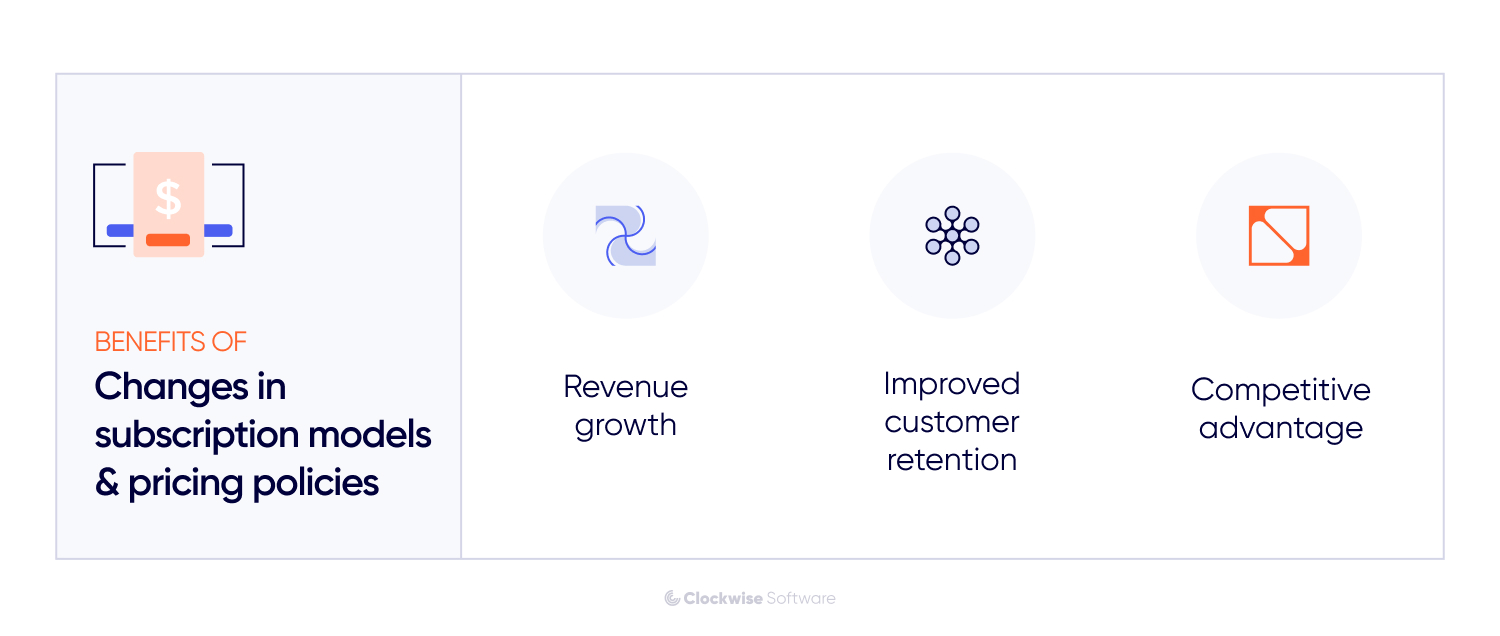
In 2024, businesses worldwide spent an average of $8,700 per employee annually on SaaS products, $800 more than a year ago. What a jump!!
This growth is something experts call “SaaS inflation”, and it’s even outpacing inflation in many countries. It's crucial for businesses to manage their spending effectively. Searching for optimization opportunities, they may consider cutting back on certain products.
So, what does this mean for you? You have to offer your users flexible subscription options. It lets them optimize their spending without the need to give up on your SaaS product.
Here are the main types of flexible SaaS subscription models:
- Usage-based. Charge customers based on how much they use your software — like the number of transactions or hours of use. Think of it like a utility bill, where they pay for what they consume.
- Pay-as-you-go. This is like the usage-based model but even more flexible. Customers pay for the software as they need with no fixed monthly commitment.
- Tiered pricing. Offer multiple subscription levels such as Basic, Pro, and Enterprise. Each tier comes with its own set of features and pricing.
- Freemium model. Provide a free tier with limited features to attract new users. This gives potential customers a risk-free way to try out your software. When they're ready for more advanced features, they can upgrade to a paid version.
Remember, the right subscription model can make a big difference in attracting users and keeping them engaged. Feel free to mix and match these approaches to see what works best for you!
Business value
Here’s how these changes in pricing can benefit you as a SaaS providers:
- Revenue growth: Research shows that SaaS companies with usage-based pricing are seeing impressive growth — about 38% annually! While 72% of vendors still stick to annual plans, it’s clear that offering flexible pricing can help you attract a broader range of customers. More options mean more potential revenue!
- Improved customer retention: When pricing matches with how customers actually use your services, it creates a much better experience. Studies reveal that keeping an existing customer is five times cheaper than acquiring a new one. Happy customers are not just likely to stick around; they may also upgrade their plans over time, boosting your bottom line even further!
- Competitive advantage: With more businesses jumping on the flexible pricing bandwagon, those that don’t might risk being left behind. Offering unique pricing options can set you apart from the crowd, attracting customers who are looking for solutions that fit their specific needs.
To really illustrate why flexible pricing is becoming such an important trend in the SaaS world, let’s take a look at some successful examples. This is where you can see the real impact in action!
Real world examples
Let’s take a look at some SaaS products that fully benefit from this trend, including ones we worked on:
- Workerbee hired us to build a marketplace for software consultants. One key challenge was setting up flexible payment options. They requested not just credit card or ACH transfers, but also net-30 payment terms for post-service billing. Our team stepped in and developed modules for their admin panel, providing Workerbee's customers with the payment flexibility they required.
- Zendesk. Back in August 2024, Zendesk took a big step with its new outcome-based pricing model for AI agents. Basically, businesses now pay based on the actual results these AI agents deliver. If the AI resolves an issue successfully, that’s when you see the cost.
- Hubspot. On March 5, 2024, HubSpot launched seats-based pricing, offering both paid edit access and free view-only seats. This flexibility lets users configure their team setup based on exact needs without overspending.
Shifts in subscription models and pricing policies are changing the game for SaaS businesses of all sizes. This newfound flexibility helps users find solutions that match their unique needs while maximizing the value from the tools they choose.
At Clockwise Software, our SaaS experts and business analysts have extensive experience in developing and implementing various subscription models and pricing policies.
Let's work together to find the best options for your business needs!
Emphasis on SaaS security
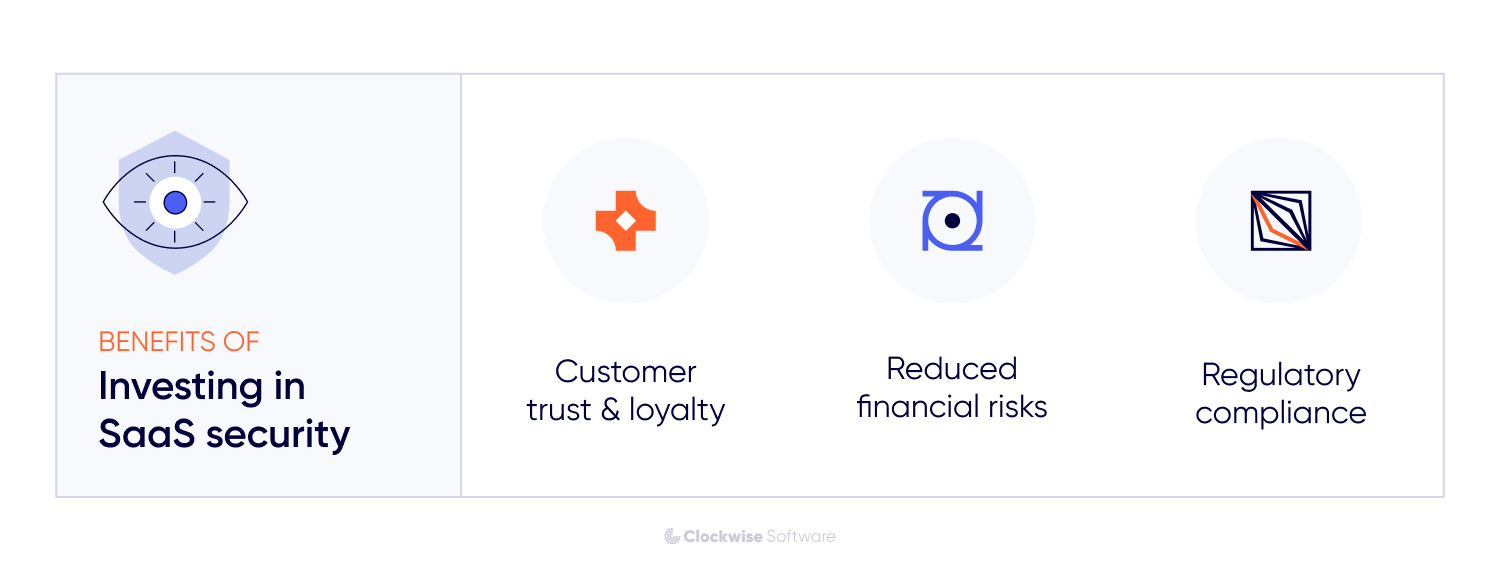
Unfortunately, SaaS applications are often at risk of cyber threats for a few reasons.
- One of the big ones is their multi-tenant SaaS architecture. This design lets multiple users share the same infrastructure. But a breach in one part of the system could put everyone at risk.
- Another concern is that the very accessibility of SaaS apps can make them more vulnerable to unauthorized access.
- Plus, misconfigurations can happen, and they often result in security gaps.
As these threats grow, a stronger focus on SaaS security is more important than ever. Let’s break down why this emphasis is so crucial for your business.
Business value
Investing in security for your SaaS offerings comes with some serious benefits:
- Customer trust and loyalty. When your customers know their data is safe with you, they’re more likely to stick around. A solid reputation for security can set you apart from the competition. In fact, 75% of US consumers would stop buying from a company that experienced a data breach. By prioritizing security, you’re showing your customers that you care about their privacy and data protection.
- Reduced financial risks. The financial impact of a data breach can be brutal. IBM estimates that the average cost of a breach is around $4.35 million! Investing in security measures greatly lowers breach risks. It saves your company from costly fines, legal troubles, and lost business.
- Regulatory compliance. Many industries have strict data security rules. Not following them can lead to serious penalties. By beefing up your security, you ensure your SaaS product meets regulations like GDPR or HIPAA. This not only protects you from fines but also boosts your credibility, showing customers that you take compliance seriously.
Let’s highlight some shining examples of businesses that are taking SaaS security to the next level.
Real world examples
Here’s a look at how some industry leaders are stepping up their SaaS security:
- Buffer rolled out advanced encryption and two-factor authentication to keep user data safe. What’s even cooler? Buffer is all about transparency. They actively share their security practices. This builds trust, especially among small business owners worried about data protection.
- Microsoft Azure doesn’t mess around with security as well. They provide comprehensive measures, including continuous threat monitoring and advanced encryption, along with compliance certifications to give businesses peace of mind.
- Zoom made major improvements to their security features after facing some security challenges back in 2020. They introduced enhanced encryption and better user controls. Their focus on transparency and communication helped rebuild trust with users.
As more businesses depend on cloud solutions, understanding the security behind their software is essential for keeping data safe and maintaining customer trust.
At Clockwise Software, we believe strong security isn’t just a nice-to-have — it’s a foundation for success. Our tech experts are always on the lookout for the latest cybersecurity tools and methods to protect our clients’ SaaS solutions.
Development of white-label SaaS products
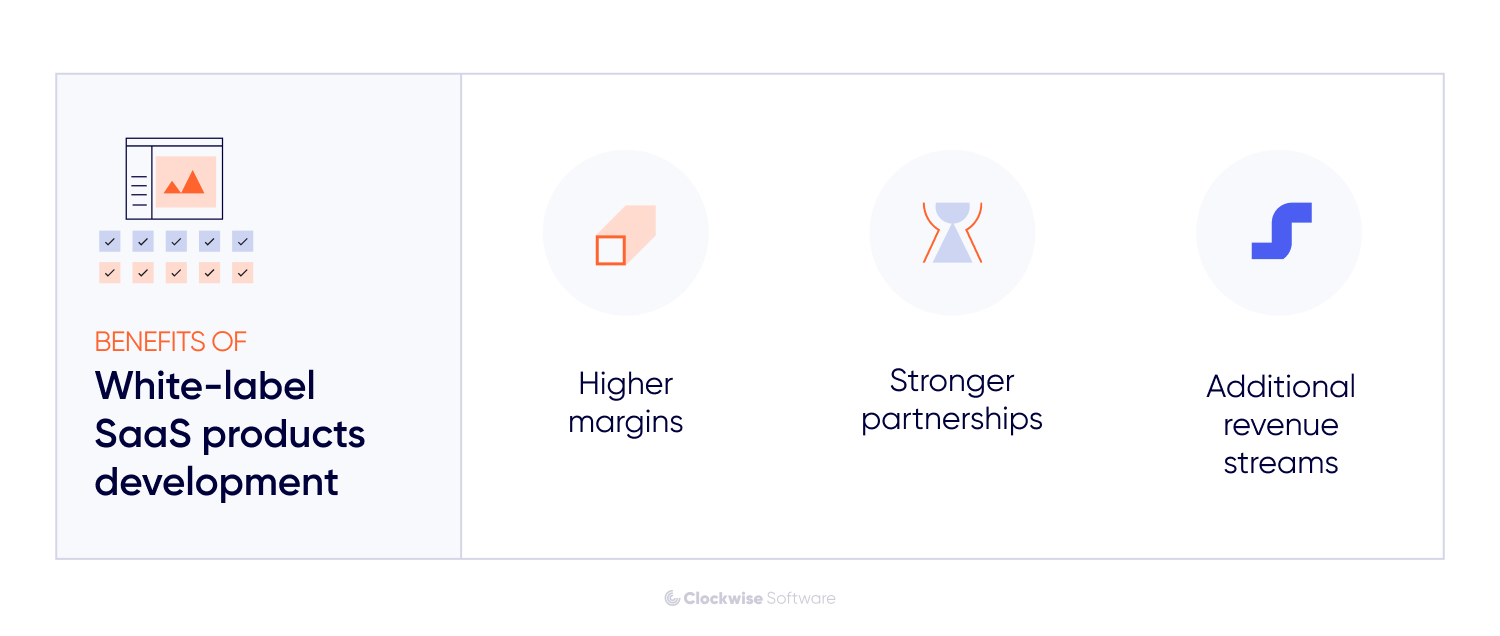
Imagine this: a talented chef whips up an incredible dish. But instead of serving it in their own restaurant, they let other places put their name on it and sell it as their own. That’s the magic of white-label SaaS!
As a white-label SaaS provider, you have the unique chance to create powerful, customizable software that other businesses can brand and use to enhance their services. It’s a win-win — you provide them with a solid product, and they get to offer it under their own name.
Today, speed and efficiency are everything. The demand for white-label solutions is skyrocketing because companies want to tap into existing technologies and meet customer needs without the long wait of developing something from scratch.
Business value
Here’s why developing white-label SaaS is a smart move:
- Higher margins. When you invest in a core product that multiple clients can brand, you spread development and maintenance costs across a wider user base. This keeps your costs manageable while allowing you to keep enhancing your product.
- Stronger partnerships. White-label solutions foster long-term relationships with your clients. As your clients grow, your product becomes part of their success story, leading to loyalty, referrals, and more business opportunities.
- Additional revenue streams. With white-labeling, you create another source of income without having to build a whole new product. Instead of relying solely on direct customers, you can sell your product to other businesses. Just make sure to research your market first so you know there’s demand for your solution!
Let’s check out some success stories of companies that are rocking the white-label SaaS game:
Real world examples
We witnessed firsthand how white-labeling can benefit SaaS companies, both from our clients' experiences and industry leaders. Let's start with a case from our own experience:
- Whitelance. Crowdskills, a platform connecting freelancers with clients, came to us looking to turn their marketplace into a white-label platform. Our team revamped their existing app to enable multi-tenancy and facilitated their SaaS migration. Now, Crowdskills customizes the Whitelance platform for their clients, helping them launch freelance marketplaces in just a few days! What started as a side project for Crowdskills, has turned into a thriving standalone business.
- Shopify. Shopify is a shining example of white-label success. They offer a user-friendly platform that allows entrepreneurs to quickly launch their online stores without needing to create everything from scratch. TWith around 5.23 million live stores, Shopify has empowered countless startups to dive into e-commerce.
- Vendasta. Vendasta provides a white-label platform for social media management. Agencies can rebrand and sell Vendasta's tools, giving their clients a way to manage their online presence without having to develop their own solutions. With over 50,000 channel partners using Vendasta’s platform, it’s clear that white-labeling works!
White-label SaaS development is a fantastic opportunity for providers looking to expand their reach and enhance their offerings. By embracing this model, you can deliver customizable solutions that meet your clients’ diverse needs.
As the demand for white-label solutions continues to grow, positioning yourself as a reliable provider will be key to your success.
At Clockwise Software, we know white-labeling inside and out. Whether you need insights on best practices, technical expertise, or strategies for scaling your offerings, we've got your back!
Ready to turn your existing software into a white-label app?
We have built such platforms and know how to launch another revenue stream for you
Read also:How to Launch White-Label Platform
Sustainability and energy efficiency
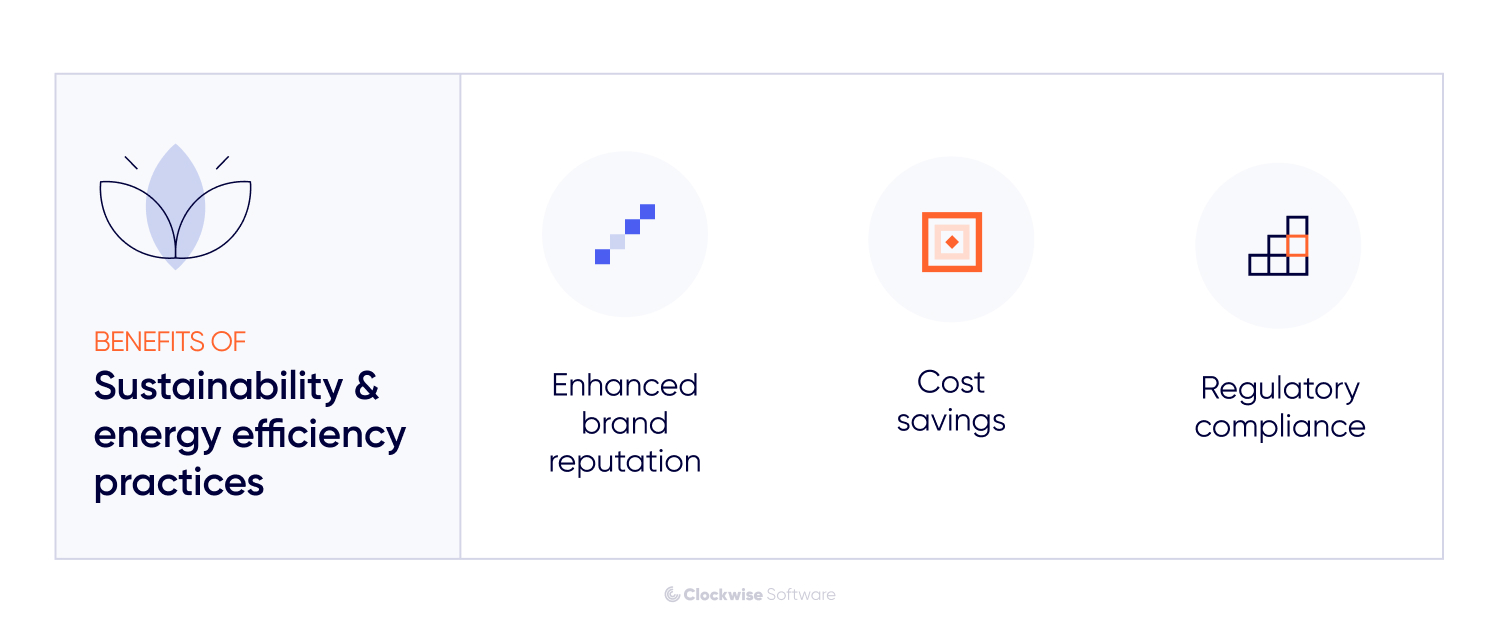
In the EU, all businesses with over 500 employees are required to disclose this information, and in the USA, the SEC is actively pushing for all public companies to include this data in annual reports and other documents.
But even if these regulations don’t apply to your business yet, there’s a growing demand from customers and investors for eco-friendly practices. People want to support sustainable brands, and investors often look for ESG metrics before they make a move.
So, why not make sustainability a part of your business model?
Business value
Now, you might be wondering, “How does focusing on sustainability help my business?” Let’s break it down:
- Enhanced brand reputation. Nowadays, customers love supporting brands that care about the planet. By adopting green practices, you can attract eco-conscious customers and set your brand apart.
- Cost savings. Energy-efficient tech isn’t just good for the planet—it’s good for your wallet. For example, companies that focus on energy efficiency can save up to 20% on their energy bills, according to the Carbon Trust.Think about how you could reinvest those savings!
- Regulatory compliance. Environmental regulations are only getting tougher. Being proactive keeps you ahead of the game, helping you avoid fines and compliance risks.
It all sounds good on paper, but can you achieve this without sacrificing business success? Let’s see how other SaaS companies managed that.
Real world examples
Want to see how the big players are doing it? Here are a few examples of industry leaders who are making sustainability work for them:
- Salesforce. This cloud CRM powerhouse is not just about business success — they’re also on a mission to cut their carbon footprint. They’ve committed to 100% renewable energy globally and have implemented initiatives to boost energy efficiency in their data centers.
- Microsoft. With a goal to be carbon negative by 2030, Microsoft is investing heavily in green tech. Their goal to remove more carbon from the atmosphere than they emit shows just how impactful a commitment to sustainability can be.
- Google. A pioneer in sustainability, Google has been using renewable energy for its data centers since 2017. Their goal is to run on 24/7 carbon-free energy by 2030. They’re setting a strong example in the tech world by pushing innovation with a purpose.
Sure, big companies have the resources to invest heavily in green practices, but you can make a difference too! We’re here to help you identify eco-friendly practices that fit your business. Whether it’s choosing energy-efficient hosting solutions or optimizing your software to use fewer resources, we’ll work together to make your SaaS business more sustainable.
Are you ready to dive into sustainability and energy efficiency? Let’s team up to create solutions that not only meet your business needs but also help build a healthier planet for generations to come.
Growing demand for collaboration tools
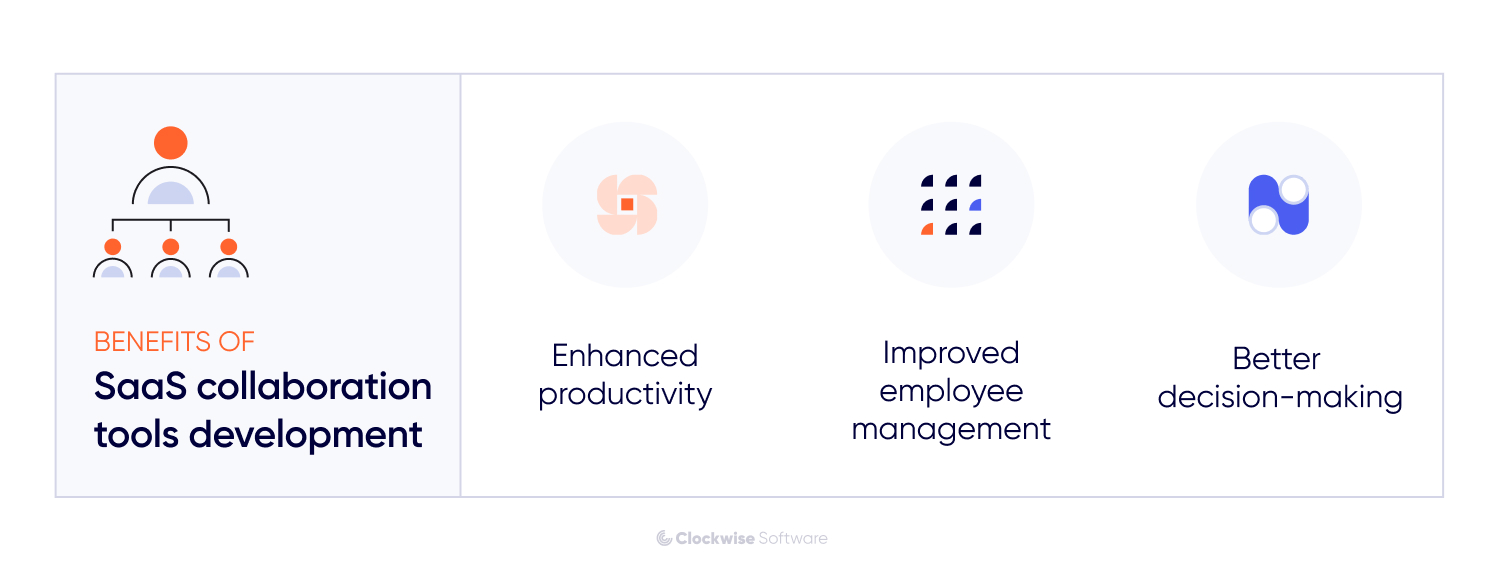
Even though some companies are calling their employees back to the office, remote work is here to stay. The most traditional workplaces are now warming up to hybrid models, allowing employees to work from home a few days each month.
But let's be real — collaborating with your team from miles away can be a bit tricky, right? That's why businesses are investing in collaboration tools and SaaS products with built-in features to keep everyone connected. These days, it's hard to imagine a design app or coding assistant without collaboration capabilities.
And sure, the market seems packed. But while tools like Slack, Microsoft Teams, and Zoom do a lot, they don’t cover everything teams need. That’s why we’re seeing a boom in virtual whiteboards and other niche tools. Over the next few years, there’s still plenty of room for new, innovative solutions in remote collaboration.
Business value
So, you're wondering why there's such a buzz around collaboration tools and how your SaaS business can ride this wave?By building a tool that truly enhances teamwork, you’re offering something valuable that customers are willing to invest in. Here’s the business value these tools bring:
- Enhanced productivity. Collaboration tools make communication smoother. Teams can share info, brainstorm, and work together in real-time, no matter where they are. Studies show that using these tools can ramp up productivity by up to 30%!
- Improved employee engagement. When it's easy to connect and collaborate, people feel more engaged and valued. Engaged employees are 21% more productive, leading to better results for your business.
- Better decision-making: Real-time feedback and brainstorming lead to better decision-making. When everyone shares their insights, decision-making improves and creativity thrives
Still think the big players have locked down this space? Check out startups that carved out their own niches and are making waves.
Real world examples
Let’s take a look at some innovative startups offering collaboration tools:
- Jamboards. They've transformed brainstorming with interactive digital whiteboards. Teams can map out ideas and collaborate live, wherever they are. And they raised $9 million – a solid proof that collaboration tools still can succeed!
- Cord. Cord is shaking up video collaboration. Their platform lets you give real-time feedback during video calls, share screens, and highlight exactly what you're talking about. They snagged $15 million in funding.
- Supernormal. Tired of taking meeting notes? Supernormal automatically generates notes and action items from your video calls. It integrates with your favorite conferencing tools so you can focus on the conversation. Recently, it received $10 million in funding.
At Clockwise Software, we get how crucial collaboration tools are today. We've built apps with collaboration features and this is how we can help you bring your ideas to life:
- Custom Solutions: We'll work with you to create collaboration tools tailored to your needs. Whether focus on project management, communication, or want to build an integrated platform, we've got you covered.
- Seamless Integration: Our team can help integrate new tools into your existing software stack, making the transition smooth and keeping your team's workflow humming.
Ready to tap into the growing demand for collaboration tools in your SaaS business? Let's team up to create innovative solutions that boost teamwork and drive success for your organization.
Conclusion
In today's crowded SaaS market, both newbies and seasoned pros are always looking for ways to innovate and stay ahead. So, what trends are shaping the future of the SaaS industry? Let's break it down:
- AI and Machine Learning: Making software smarter to offer you more intuitive solutions.
- Flexible Subscription Models: Attracting a wider audience with diverse and adaptable pricing plans.
- Micro SaaS: Focusing on specific niches to dominate smaller markets.
- Consolidation: Staying open to partnerships or mergers with other industry players.
- Stronger Cybersecurity: Tackling growing security concerns with robust defenses.
- Low-Code/No-Code and White-Label Solutions: Simplifying development to make SaaS products accessible to more businesses.
- Sustainability: Moving from just a buzzword to a business necessity.
- Collaboration Tools: Essential for success with the rise of remote work.
These trends aren't just shaping the SaaS market today—they're setting the stage for the future. Whether you're looking to boost your current product or break into a new market with your SaaS MVP, keeping an eye on these developments will give you a competitive edge in 2025 and beyond. Now's the time to embrace innovation and adapt, because the SaaS landscape is only getting more competitive.
At Clockwise Software, we've been helping SaaS companies navigate emerging trends for over 10 years. If you want to build a future-proof SaaS application but aren't sure where to start, we're here to guide you through the ever-evolving world of SaaS.
Want your SaaS product to meet user expectations and keep the revenue rolling in 2025?
We helped to create 25+ SaaS apps and know how to help you
FAQ
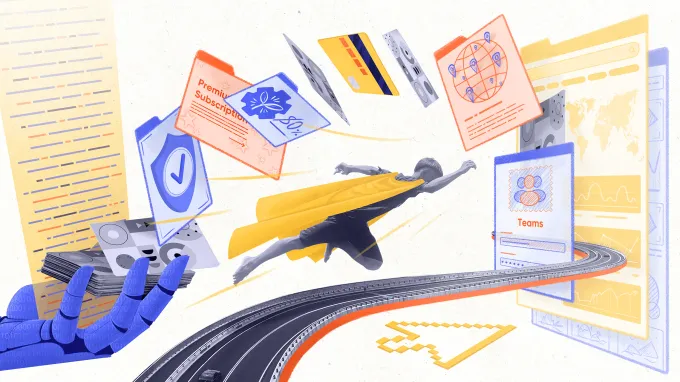
Any questions unanswered?
Let's discuss them
